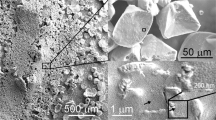Abstract
Experimental studies have been conducted to clarify the paragenetic conditions of \({\text {CaCO}}_3\) varieties, calcite and aragonite formed from the same wall rock. In addition, the solubility dependence of calcite, aragonite, and limestone formed from limestone cave in \({\text {CO}}_2\)-saturated solutions was compared with the previous studies. First, the calcite and aragonite were powdered to below 200 meshes. In addition, the powders were, respectively, added into the \({\text {CO}}_2\)-saturated distilled water at 8, 13, 18, and \(22 \,^\circ {\text {C}}\) and were kept constant for 15 days. The amount of dissolved \({\text {CaCO}}_3\) was then measured. The solubility of aragonite was higher than that of calcite, and the solubility decreased exponentially with increasing temperature. Simultaneous production and growth of calcite and aragonite proceeded only when the saturation of aragonite was reached in aqueous carbonate solution. Conversely, when the dissolved amount of \({\text {CaCO}}_3\) has not been reached, calcite is only formed and grown. In these solutions, aragonite crystals dissolve and calcite crystals grow. The degree of saturation of aragonite can be reached by rapid evaporation of solvent, \({\text {CO}}_2\) gas degassing, and the presence of Mg. However, paragenesis of calcite and aragonite in natural caves can be explained by rapid evaporation of the solvent. A rapid evaporation of the solvent may occur at a place, where a small amount of karst solution flows and a large amount of air flows. In such places, paragenesis of calcite and aragonite is possible.






Similar content being viewed by others
References
Bradley RH, David CR, Stephen HK, Steven RB (2005) The calcite–aragonite transformation in low-mg marble: equilibrium relations, transformation mechanisms, and rates. J Geophys Res 110(B03205):1–16. https://doi.org/10.1029/2004JB003302
Enguang H, Wenyu S, Shoutian C (2000) Effects of phosphate ion on the growth of aragonite whisker in heterogeneous precipitation from suspension of \({\rm Ca(OH)}_2\). Rare Met Mater Eng 29:398–402
John WM, Rolf SA (2002) The dissolution kinetics of major sedimentary carbonate minerals. Earth Sci Rev 58:51–84. https://doi.org/10.1016/S0012-8252(01)00083-6
Kralj D, Brečević L, Arne EN (1990) Vaterite growth and dissolution in aqueous solution I. Kinetics of crystal growth. J Cryst Growth 104:793–800
Lee I, Han SW, Chol HJ, Kim K (2001) Nanoparticle-directed crystallization of calcium carbonate. Adv Mater 13(1):1617–1620
Meldrum FC, Hyde ST (2001) Morphological influence of magnesium and organic additives on the precipitation of calcite. J Cryst Growth 231:544–558. https://doi.org/10.1016/S0022-0248(01)01519-6
Ota Y, Inui S, Iwashita T, Kasuga T, Abe Y (1995) Preparation of aragonite whiskers. J Am Ceram Soc 78:1983–1984. https://doi.org/10.1111/j.1151-2916.1995.tb08924.x
Plummer LN, Busenberg E (1982) The solubilities of calcite, aragonite and vaterite in \({\rm CO}_2\)–\({\rm H}_2{\rm O}\) solutions between 0 and 90 C, and an evaluation of the aqueous model for the system \({\rm CaCO}_3\)–\({\rm CO}_2\)–\({\rm H}_2{\rm O}\). Geochim Cosmochim Acta 46(6):1011–1040
Rautaray D, Sainkar SR, Sastry M (2003) Room temperature synthesis of aragonite crystals at an expanding liquid-liquid interface in a radial hele-shaw cell. Adv Mater 15:1273–1278
Sugawara A, Kato T (2000) Aragonite \({\text{ CaCO }}_3\) thin-film formation by cooperation of \({\rm Mg}^{2+}\) and organic polymer matrices. Chem Commun 6:487–488
Tai CY, Chen FB (1978) Polymorphism of \({\rm CaCO}_3\) precipitated in a constant—composition environment. AICHE J 44:1790–1798
Walsh D, Mann S (1995) Fabrication of follow porous shells of calcium-carbonate from self-organizing media. Nature 377:320–323
Xyla AG, Giannimaras EK, Koutsoukos PG (1991) Precipitation of calcium carbonate in aqueous solution. Colloids Surf 53:241–245. https://doi.org/10.1016/0166-6622(91)80140-J
Zeshan H, Minghao S, Qiang C, Sheguang D, Chenghua Z, Xiaopin W, Win D (2009) Synthesis of needle-like aragonite from limestone in the presence of magnesium chloride. J Mater Process Technol 209:1607–1611. https://doi.org/10.1016/j.jmatprotec.2008.04.008
Zheshan H, Yulin D (2003) Supersaturation control in aragonite synthesis using sparingly soluble calcium sulfate as reactants. J Colloid Interface Sci 266:353–365
Zheshan H, Yulin D (2004) Synthesis of needle-like aragonite from calcium chloride and sparingly soluble magnesium \({\rm CaCO}_3\) carbonate. Powder Technol 140:10–25
Acknowledgements
This work is supported by the National Program on Key Science Research of DPR of Korea (Grant no. 18-3-5). The assistance of Associate Professor Hwangbo Hyon throughout this study is gratefully acknowledged. Special thanks are provided to the anonymous reviewers who have helped to improve the final version of the manuscript.
Author information
Authors and Affiliations
Corresponding author
Additional information
Publisher's Note
Springer Nature remains neutral with regard to jurisdictional claims in published maps and institutional affiliations.
Electronic supplementary material
Below is the link to the electronic supplementary material.
Rights and permissions
About this article
Cite this article
Ryang, HM., Sim, HC. Formation of \({\text {CaCO}}_3\) varieties from a carbonated aqueous solution. Carbonates Evaporites 34, 1619–1626 (2019). https://doi.org/10.1007/s13146-019-00510-6
Accepted:
Published:
Issue Date:
DOI: https://doi.org/10.1007/s13146-019-00510-6




